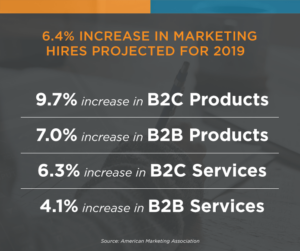The core trends influencing the marketing industry are simultaneously changing the hiring profile of the best marketing talent.
Contents
- A Quick Glance at the 2019 Labor Market
- A New Focus for the Future of Hiring
- Hiring Insights in Marketing
- 2019 from the Perspective of Key Leaders
A Glance at the 2019 Labor Market
 The national unemployment rate is at a record low since 1969 and is even lower in many industry sectors and regional markets.
The national unemployment rate is at a record low since 1969 and is even lower in many industry sectors and regional markets.
 This is a typical increase in wages, only 0.1% higher than 2018, which implies stagnant wage growth.
However, job switchers in marketing can expect a 9.1% wage increase – a highly attractive reason to seek something new.
[vc_empty_space]
This is a typical increase in wages, only 0.1% higher than 2018, which implies stagnant wage growth.
However, job switchers in marketing can expect a 9.1% wage increase – a highly attractive reason to seek something new.
[vc_empty_space]
 25.7% of employees are actively seeking new job opportunities.
And 55.5% are passively open to new job opportunities.
25.7% of employees are actively seeking new job opportunities.
And 55.5% are passively open to new job opportunities.
Best cities for jobs
Glassdoor ranks these cities based on hiring opportunity, cost of living, and overall job satisfaction:- Pittsburgh, PA
- St. Louis, MO
- Indianapolis, IN
- Cincinnati, OH
- Hartford, CT
- Boston, MA
- Memphis, TN
- Raleigh, NC
- Cleveland, OH
- Detroit, MI
Top Perks Employers are Highlighting
- Casual dress codes
- Employee discounts
- Remote work opportunities
- Extra paid time off
- Signing bonuses
- Free lunches
- Gym memberships
- Work from home Fridays
- Daycare
A New Focus for the Future of Hiring
In 2018, AI-powered recruitment technologies took off across every industry. Seeking to automate the application, screening, and interviewing processes, these tools unburden the hands, and minds, of recruiters and corporate talent acquisition professionals everywhere. However, our stance on this trend has been, and always will be, that humans are greater than machines – most especially in recruiting for highly skilled Technology, Finance, Engineering and Marketing professionals. Even with a quarter of employees looking for a new job, and over half passively interested should the opportunity present itself, employers cannot rely on the programming of their recruitment technology to make the right matches and entice the best-fit talent. This is the year that employers must focus on the human side of recruitment, specifically, the candidate experience. Here are a few numbers proving why the candidate experience is critical this year: 68% of employees believe the candidate experience is a reflection of the employee experience
68% of employees believe the candidate experience is a reflection of the employee experience
 51% of people continue to look for jobs even after they’ve accepted an offer
51% of people continue to look for jobs even after they’ve accepted an offer
 31% of candidates expect a customized message when a company reaches out with a new opportunity
31% of candidates expect a customized message when a company reaches out with a new opportunity
 55% of applicants give up if they haven’t heard back from a company within two weeks
In short, the role of the candidate experience in your recruitment process cannot be overlooked. One in seven new hires accept a job offer only to walk away at the last minute. Do not let this become your story.
55% of applicants give up if they haven’t heard back from a company within two weeks
In short, the role of the candidate experience in your recruitment process cannot be overlooked. One in seven new hires accept a job offer only to walk away at the last minute. Do not let this become your story.
Quick steps to an awesome candidate experience
- A fast and easy (and mobile-responsive) application process
- Quick feedback and responses to every candidate
- A compelling employer brand that reflects your company culture
- Personalized emails, phone calls, and messages throughout the process
- A short, but thorough, interview process
- A clear understanding of the benefits and perks you offer
- An efficient and valuable onboarding process
Hiring Insights in Marketing
 The digital marketing industry, valued at the beginning of 2018 at $192 billion, is expected to grow to $306 billion by 2020. That’s massive, exponential growth, putting the demand for marketers at an all-time high. In fact, marketing manager is the 3rd best job according to Glassdoor, a ranking based on number of job openings, salary, and overall job satisfaction.
That said, marketing is yet another field feeling the pain of a skills gap. CMOs agree that finding marketing talent is one of their biggest challenges in today’s market.
The cherry on top of this talent shortage is that a reported 97% of marketers are open to new opportunities – usually to gain a better salary or career advancement. Although only 19% are actively searching for a new job, this is still massive cause for concern.
The digital marketing industry, valued at the beginning of 2018 at $192 billion, is expected to grow to $306 billion by 2020. That’s massive, exponential growth, putting the demand for marketers at an all-time high. In fact, marketing manager is the 3rd best job according to Glassdoor, a ranking based on number of job openings, salary, and overall job satisfaction.
That said, marketing is yet another field feeling the pain of a skills gap. CMOs agree that finding marketing talent is one of their biggest challenges in today’s market.
The cherry on top of this talent shortage is that a reported 97% of marketers are open to new opportunities – usually to gain a better salary or career advancement. Although only 19% are actively searching for a new job, this is still massive cause for concern.
Top digital marketing trends
- Interactive chatbots
- Voice search
- AI and blockchain
- Influencer marketing
- Security and data privacy
- Personalized messaging
- Data analytics
Most valuable skills when hiring marketing talent
- Creativity
- Natural leadership abilities
- Emotional Intelligence
- Curiosity
- Marketing platform experience
- Data science background
2019 from the Perspective of Key Leaders
 “Low unemployment and increasing skills gaps continue to plague employers who are struggling to fill roles at all levels within their organizations,” said Matt Ferguson, CEO of CareerBuilder. “Fifty percent of U.S. employers reported that it is taking them longer to fill jobs today compared to any other period of time — a trend that is ultimately giving job seekers more leverage.”
“Low unemployment and increasing skills gaps continue to plague employers who are struggling to fill roles at all levels within their organizations,” said Matt Ferguson, CEO of CareerBuilder. “Fifty percent of U.S. employers reported that it is taking them longer to fill jobs today compared to any other period of time — a trend that is ultimately giving job seekers more leverage.”
How Are You Overcoming the Marketing Talent Shortage?
You’re probably gearing up for 2019 hiring, but some of these statistics might be concerning. For us, these statistics are eye-opening. We’re always looking for new ways to partner with companies to overcome these challenges. Our talent acquisition solutions are one-part relationships, one-part insight, and one-part results. It’s a recipe that works every time, and we’d love to introduce you.We want to partner with you. Let’s chat.
Share This Post [social-share] More Like ThisIf you want to place key positions faster, you need to avoid this six common recruitment mistakes. Here’s how to do it.
Find out how Brightwing’s 5 Tips for Purpose-Driven Recruiting can help improve your internal recruiting process for identifying higher quality candidates.
Before you decide quitting your job is the best idea, consider theses five things to make sure this is the right move for you
Negotiate a job offer successfully with a variety of tips and advice that’ll guide you through every step of the negotiation process.
It’s career fair season! This year, Brightwing plans to attend 6 IT and/or Engineering career fairs – 4 in Michigan, 1 in Ohio, and 1 in Texas.
Today’s quick and fast recruitment solutions are not showing the real value in talent acquisition. The focus should be on quality of resumes not quantity.|Today’s quick and fast recruitment solutions are not showing the real value in talent acquisition. The focus should be on quality of resumes not quantity.|Today’s quick and fast recruitment solutions are not showing the real value in talent acquisition. The focus should be on quality of resumes not quantity.
%%sitename%% %%sep%% Staying creative in the workplace can be challenging, even if you work in a creative environment all day long.


